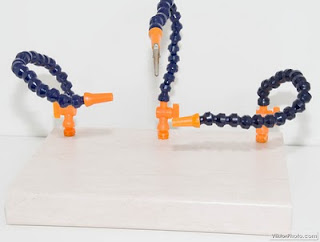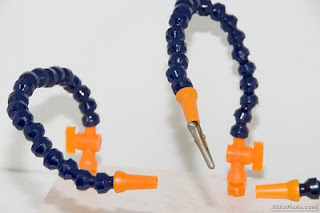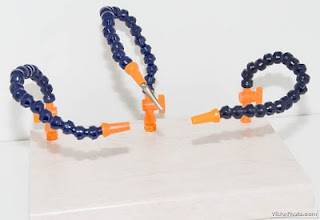Introduction
“A good technician has 3 hands – it is the fourth one that’s missing sometimes.” I think the famous proverb sums it up: Many times there are many, possibly tiny, parts that need to be balanced in an awkward position with one hand, while using a screwdriver/pliers/tweezers/soldering iron with the other one. This often tries even the most patient ones. And I am not one of them. After many trials and failures I ended up with this design that seems to work for me.
 |
| The finished product with 3 hands |
Bill of materials
- A big chunk of wood in the desired size – I went to the local carpenter shop and checked what scrap material they have. I found in the corner (under a pile of waste pieces waiting to be thrown away) a leftover piece of a kitchen’s working surface. It’s 4 cm thick, made of compressed chipwood with a “nice” coating to fit someone’s kitchen. I had it cut to a 20 cm * 30 cm rectangle. The resulting piece is small enough to be portable (in my extremely limited working corner nothing is permanent) yet heavy enough to be not wobbly when working with it. This is very important as I had found out by using other, lighter designs.
- A few pieces of Multi Direction Plastic Water Oil Switch Pipe Adapter . I used 3 pieces in my design but you may want to use more or less. Make sure you get the ones that have a screwy end at the bottom. The advantage of this kind of pipe is that it can be tailored to ones needs. You can any time add, remove sections of it, change the endings etc. – the limit is your imagination.
- Alligator clips for the end of the pipes to hold whatever you may want to hold. It can be a PCB, some wires or a magnifying glass.
 |
| Close-up of the hands |
Tools
- Drilling machine with drill bits matching the diameter of the pipe adapter’s bottom section.
- Pliers to help screwing in the bottom sections into the wooden base
Assembly
- Mark the place where you want the pipe sections to be based on the wood. Don’t put them too close to the edge – the chipwood won’t last that way. I found that a distance of around 2.5 cm is sufficient from the edges.
- Drill holes for the base sections in the wooden base. When drilling big holes I always start with a small drill bit then work my way up to the desired diameter. The bottom of the pipe section I used is 12.5 mm, so I drilled 12 mm holes for them. This will allow them to be screwed in easily with pliers (remember, it’s a very soft material).
- Screw in the bottom pieces in the holes. If needed, use a pair of pliers.
- Insert the alligator clips into the pipe endings. You may want to use pliers to adjust the diameter and shape of the alligator clips you have. If needed, you can also apply some hot glue or other kind of glue to secure it in place.
- The Helping Hands are now ready! You can twist them, turn them any way you wish and the base won’t move.
 |
| The first section of the pipe after the bottom piece is a tap. I don’t use it in this design but left it there to add extra length to the assembly. |
Like this:
Like Loading...
Related





Thanks for the idea! I built one just like it:
http://simmonmt.blogspot.com/2011/03/helping-hand.html
@simmonmt: I'm glad you find this useful!